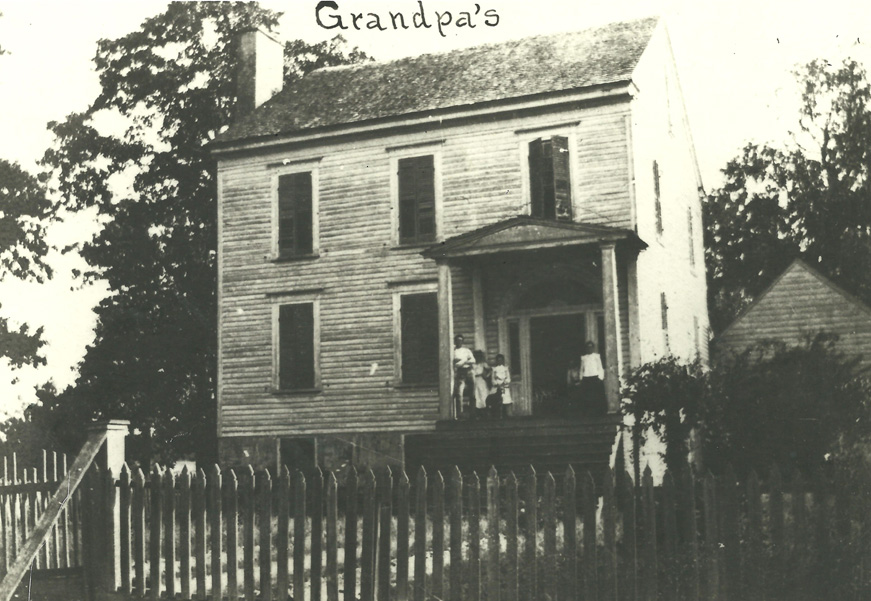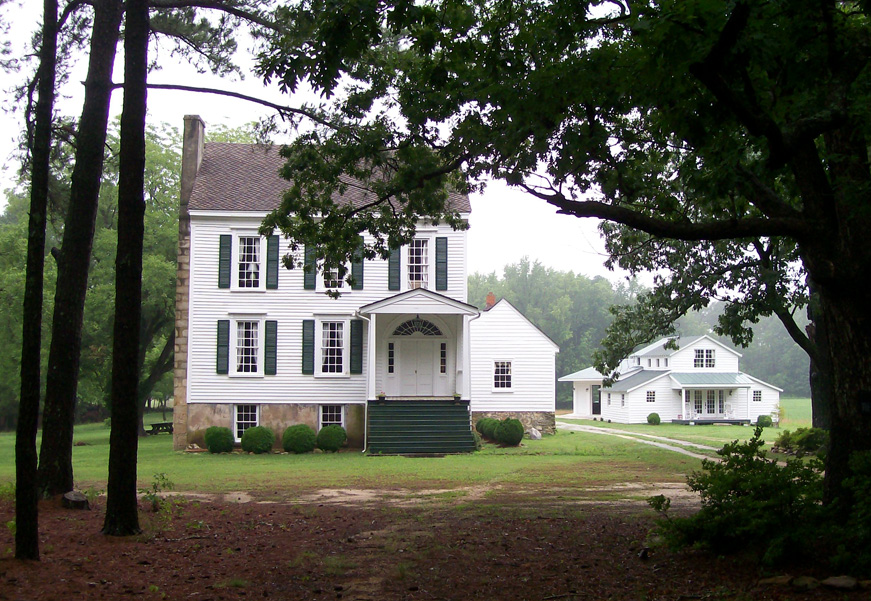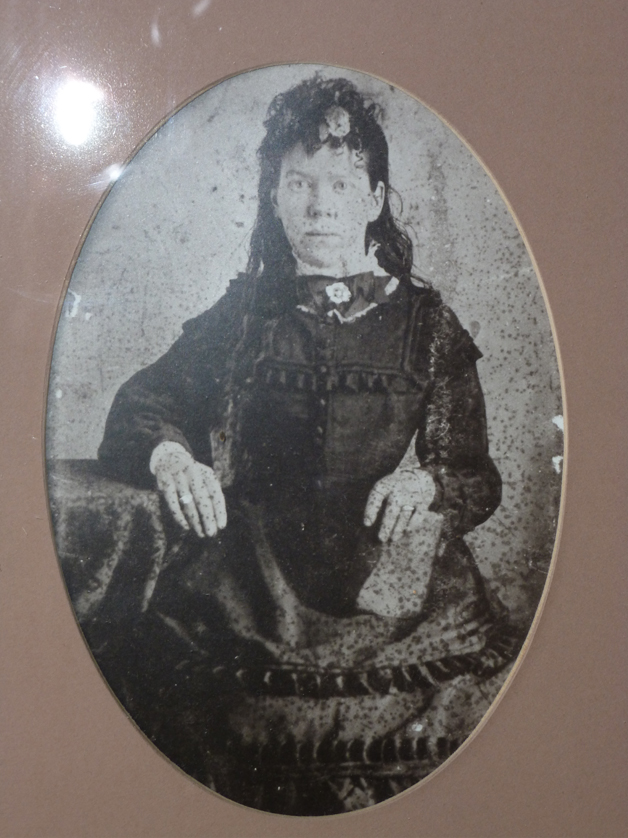EDITOR’S NOTE
A copy of this manuscript was passed to my husband and I several years ago by Dave Haywood, a grandson of the author, Nancy Cornelia Heptinstall Van Wormer. My husband, Charles Vaughan, is the owner of the Heptinstall House Plantation in Halifax County, North Carolina and we have been involved with the restoration of this house for over forty years. I found this manuscript to be a real treasure providing us with a rich understanding of the family that lived in this house and their struggles with the challenges of life during the post civil war period in northeastern North Carolina. With permission from two of her grandchildren, this manuscript has been edited and posted on this website. My sincere thanks to them.
In editing of this manuscript, I had to make some decisions about the style and content. The author, Nancy Cornelia Heptinstall Van Wormer, began her writing apparently with the intention to fictionalize her story, using names different from the actual family names yet the events were real and rang true with family stories. I therefore decided to put the correct names in the manuscript and have included a family ancestry chart at the end of the book. This should assist with clarification of the relationships. Secondly, Nancy’s education, being typical of those times, was mostly acquired from early country schools although she did have some early years of enrollment at the Littleton College. The sentence structure in the manuscript was often colloquial and confusing. Attempting to maintain her authentic voice, I have rearranged some of her sentences and added some punctuation. Thirdly, to fully illuminate the story of this women and the Heptinstall House Plantation, I have included editor’s notes and photographs.
Copyright 2015 by the Estate of Nancy Cornelia Heptinstall Van Wormer
Anyone seeking permission to reproduce or excerpt, contact This email address is being protected from spambots. You need JavaScript enabled to view it.
Karen Dunlap Vaughan, June 2015
INTRODUCTION
This book is an extraordinary story of an ordinary life.
Nancy Cornelia Heptinstall, 1881-1975, was born to the southern plantation lifestyle, but lived in the traumatic post civic war times that brought upheaval to traditions and circumstances. She was a granddaughter of the Reverend John Wesley Heptinstall. His son and her father, John Olin Heptinstall introduced nancy to the art of keeping a diary early in her life. Through it, she probed the questions of life, education, career, religion, marriage, and children. She married a “Yankee” and with her family, moved around forty times, living in both southern and northern states. In the 1960s, Nancy sequestered herself in a room with her manual typewriter and spent hours organizing and hammering out her story. Her honest, humorous, and insightful story gives the reader a true glimpse of the sheltered southern girl struggling with a changing world. It was Nancy’s dream to have this manuscript published.
To bring some closure to the story, I asked her grandson to write some of his remembrances of her and they are included at the end of her manuscript.
THE HEPTINSTALL HOUSE PLANTATION
This house is located in Halifax County, North Carolina near the town of Littleton. It was listed in 1978 on the National Register of Historic Places as the Edmunds-Heptinstall House.


BACKGROUND OF THE HEPTINSTALL HOUSE.
As referenced in the application for the National Register, this house was probably built in the 1830s or 1840s for William Howell Edmunds [1815-1862] who sold it in 1855 to the Reverend John Wesley Heptinstall [1814-1891], a planter and active Methodist leader. It was probably built by Benjamin A Edmunds, the father of William Edmunds as a wedding gift for his son. Upon the death of his in-laws, William, a lawyer and a planter, moved to Kentucky to manage the considerable estates of his wife’s family. Nancy’s Diary relates that the house was to be a school so there must have been some discussion on what to do with the nearly completed residence.
The Reverend John Wesley Heptinstall was living at the time in his home place, "Bamboo" near the town of Halifax in Halifax County, North Carolina. His parents were William Heptinstall [1775-1822] and Dolly Bradshire/Bradsher/Brasseure [1775-1848] who were also from Halifax County NC. John Wesley’s father died when he was very young and there exists a court document on file dated 1833 regarding termination of guardianship for John Wesley, his brother Jesse and his sister Dolly Langford.
Not much is known about John Wesley’s early life, but after purchasing the Heptinstall House Plantation around age forty, he was involved in both ministerial duties and businesses including a lumber mill, grist mill, general store, and a cotton gin.
The Heptinstall House Plantation has remained in family ownership since 1855 and today is owned by the great great grandson of the Reverend John Wesley Heptinstall. Six generations of the family have lived in this home.
More information about the house can be found in the application for the National Register and in the house menu on the website.
NANCY’S DIARY
By
Nancy Cornelia Heptinstall Van Wormer


Over one hundred years ago, there was under construction a building in northeastern North Carolina that upon completion was to be dedicated to educating the sons of farmers who owned and tended small farms but had never realized profits beyond a meager living for their families.
Unfortunately, when the said building was half finished, the good citizen with the good intentions found that he had run short of cash and being unable to interest a co-investor was forced to put it up for sale. There was no paper in the county at that time so it had to be advertised from mouth to mouth by the inhabitants of the county. It was eventually sold to one John Wesley Heptinstall who lived twenty-five miles away in the town of Halifax, North Carolina.
The now very old building still stands and within its now worn and cracked concrete basement floor can still be seen the figures Eighteen Hundred and Forty-Three.
As this Diary is being compiled, time has obliterated all of its homey attractiveness of this home that being achieved through effort, love and care in establishing a home in which a family of five children were born and raised. For this family, fond memories still linger and the unforgettable warm hospitability and gracious living will ever linger down through the years. [Editor's Note: The house was renovated and restored in the last fifty years.]
This old house still serves as a home, but the pomp and glory of the nineteenth century in the old South is no longer visible.
John Wesley Heptinstall was born in crossroad area named Bamboo Corners, located near the town of Halifax NC, in eastern North Carolina. He inherited from his father, a house and six-hundred acres of excellent pasture land along with a small general store. Both of these yielded well over several years and created a desire in this devoted father of three children to attain more land and a larger home.
1855
When John Wesley was told about a “half-house” in the upper country, he at once became interested, wondering what his wife Nancy Ann Sledge would have to say. When he mentioned it to her, he was assured that she wanted whatever would make him happy, so he made a quick decision to make the trip of investigation at once.
This place was twenty-five miles up-country and that meant a long drive to the music of the rhythmic trot of a horse. John Wesley hitched up his “old Faithful” and bid his family goodbye; He began the journey that was to bring his wishes to reality.
John Wesley had been told much about the town of Littleton that was located only seven miles north from the half-house. This would be a shorter drive for access to stores and markets than his current drive to Weldon which was twenty miles from his home in Bamboo Corners.
Time could not be hastened on this trip, so he availed himself of the opportunity of taking in the scenery, deciding that he liked the looks of this upper country. His current house was is a much lower portion of North Carolina.
When he was about a mile from this new house, he found himself upon a hill that was known as the Mill Hill and from which he could clearly see the unfinished house upon Sunset Hill. There was between these hills, a valley that was to become the greatest pasture land in the county. It was located between two creeks that frequently over-flowed; keeping the grass that grew beneath the bull-rushes green the year round, ruling out the necessity of cultivating food for the cattle and the sheep.
On reaching his destination, John Wesley was met and welcomed by the owner of the place, William H. Edmunds, who immediately took him to a “workers shack” that had been put in order for his stay. Even though he was tired from his journey, they remained up until far into the night talking business and getting acquainted. John Wesley gained much information as to the land-markers on the legal papers that were presented, and after being told that three thousand acres of land could be purchased with the unfinished house, they agreed on a horse-back trip to inspect the land and house the next day.
While riding through the dense forest, John Wesley made special note of the great quantity of ripe and ready-to-cut lumber, and when he was directed to the idle saw mill that was flanked by piles of cut boards, he was intrigued, knowing that if this deal went through, there would be immediate need for much ready-to-use lumber. He had been shown a crudely put-together stable that could be used for a short time, but a barn, general store, cotton gin, and grist mill would have to come under the hammer as soon as possible.
When this tour of inspection was ended and another day dawned, John Wesley spent some time studying the half house that he would have complete in a way that would not be too unsightly for a home. He finally decided to hire an experienced builder and leave the results to him.
An agreement was reached and the two men left for Halifax, the county-seat, where papers were drawn up and the deal was closed. All cut lumber and the saw mill was included in the deal and John Wesley’s small owningin Bamboo Corners were given in partial payment on the newly-acquired property. The gentleman of the deal stated that he the small home for himself and his wife.
As John Wesley returned to the only house that he had ever known, he began to realize what a mammoth undertaking he had assumed. Most of the three thousand acres of land that he had purchased had never been under the plow. He had a few share tenants who would remain on the plantation, but the small acreage of current cultivation that they required was a mere drop in the ocean of heavy production that could be accomplished. He would need more people working on the plantation.
A bright smile was upon the face of this devoted husband and father as he unfolded his plans to the loved ones. John Wesley was much pleased with himself too, realizing his great accomplishment of his desires of many years standing in so short of time.
He watched his wife’s reaction with grave interest. She was very nervous and high-strung so he wondered how she would stand the breaking up of this home and the establishing of a new one.
John Wesley had given himself six weeks to vacate the current residence, selling the contents of the store, and disposing of the pastured sheep since he deemed them to delicate to be driven on foot the twenty-five miles. Fowls and hogs could be penned in wagons and taken to the plantation. Mules, extra horses, and cows could be driven there on foot.
John Wesley’s first move towards looking ahead was to send a man to the newly-purchased plantation with orders to get any help that he could and build a fence around as near six acres as could be reckoned, placing the entrance gate on the north side facing the county road. This work would require quite a few workers if it was to be finished before moving time, so instructions were given to this very capable white man to pick up help, as he drove through the country, such as slaves that could be had for a few weeks, and even whites who might accept work for a short period to earn a little cash. The boss of the job was supplied with a wagon and two horses, with provisions in quantities from the store and a promise from John Wesley that he would come in about two weeks.
All that John Wesley could do now was to wait until such time as he could get away from the many chores that he had to attend to at home such as getting the store stripped and the pastured sheep delivered to a man who had purchased the flock. The store stock had to be inventoried. It was taken from the shelves as the man would only purchase it this way.
After these two jobs were completed, John Wesley left in his buggy for the new quarters, finding on arrival that the fence was progressing very rapidly. He knew now that there would be a place in which the stock and the fowls could be loosed upon arrival. Several of the hired men were glad to go to work at the saw mill as soon as the fence was completed. This knowledge was indeed very comforting to John Wesley as he had already discerned that there would be enough ready cut lumber to complete the very necessary enclosure. The house itself was not to come under the hammers until after the family was moved. John Wesley wanted to be around when that particular task was undertaken.
When at the end of six weeks, the gate to the finished grove was opened for the family to enter their new home. Nancy Ann experienced her first twinge of longing for the old home and her lifelong friends that she had left behind, but not a word was uttered by her. The kids were quick to remark that it was a queer looking house. It did have a one-sided appearance, all balance being on the left side with two large rooms and on the right side a large hall that ran the entire distance to the back of the house. The ones on the living floor were said to have been class rooms and above them, sleeping quarters for the boys, while the fourth floor was left undivided and to be equipped for something akin to a gymnasium.
Read More
Read the entire diary by downloading it here.